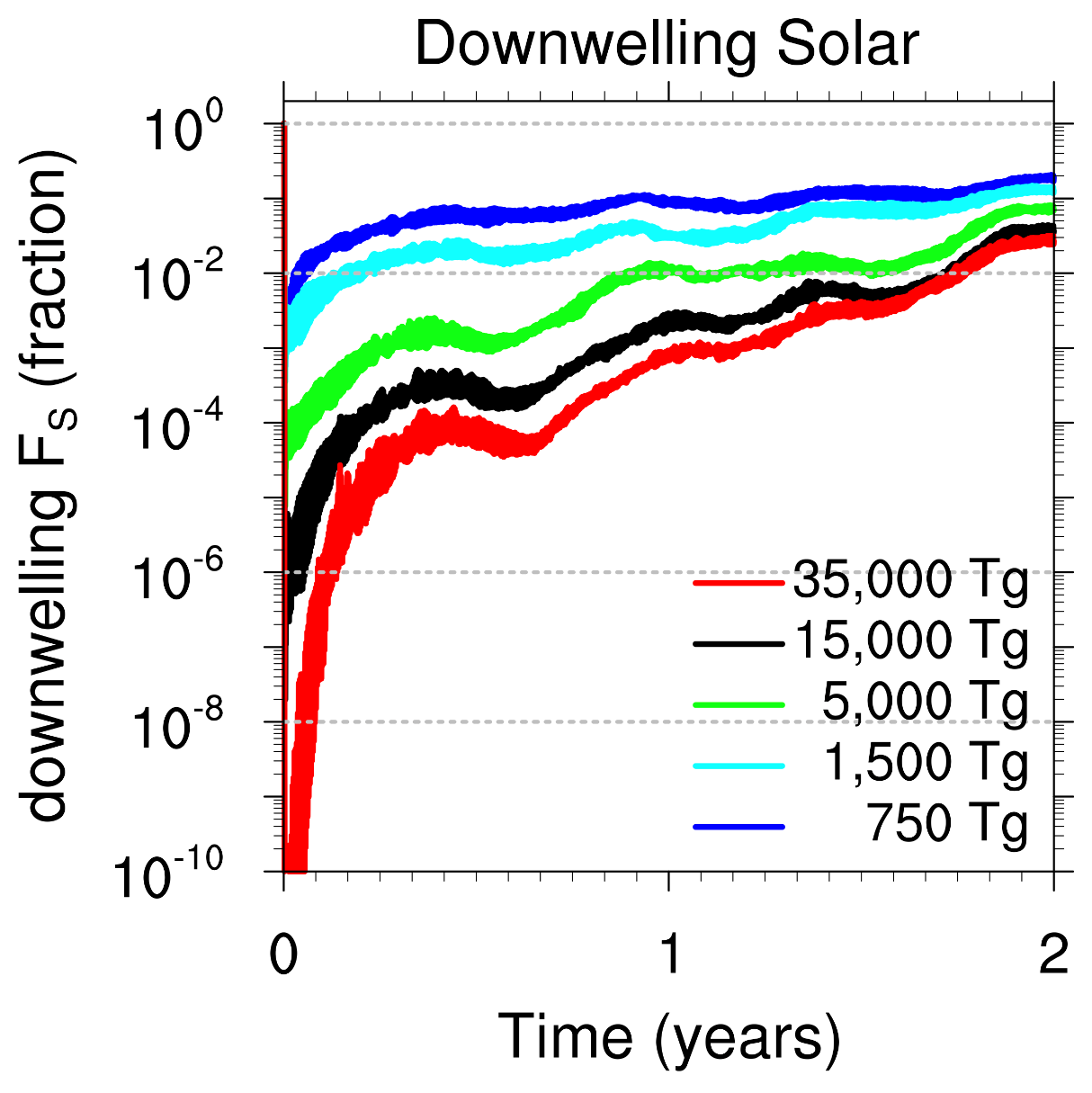1A: Climate change from soot injections at the Cretaceous-Paleogene boundary
The most recent of Earth’s five largest mass extinctions occurred at the Cretaceous-Paleogene (K-Pg) boundary, about 66 million years ago. It led to the disappearance of the dinosaurs and coincided with the impact of a 10-km asteroid at Chicxulub, in the Yucatán peninsula (Alvarez et al., 1980; Schulte et al., 2010). A world-wide soot layer is found at the K-Pg boundary that is estimated to contain a total of 15,000 Tg of fine soot (Wolbach et al., 1990). This soot is thought to have been produced by global fires triggered when rock, vaporized and propelled to great heights by the asteroid impact, recondensed and re-entered the atmosphere. These rock “spherules” were heated by friction and produced an infrared heat pulse intense enough to ignite vegetation (Melosh et al., 1990) and kill exposed animals. The amount of soot found at the K-Pg boundary is sufficient to account for the burning of the entire plant biomass at the time of the impact.
Using the NCAR Whole Atmosphere Community Climate Model (WACCM), a high-top Earth system model with full chemistry, an interactive ocean, and advanced aerosol microphysics from the Community Aerosol and Radiation Model for Atmospheres (CARMA), Bardeen et al. (2017) simulated the climate effects of the K-Pg soot injection. Soot is a very good absorber of solar radiation, which heats the air and lofts it into the stratosphere, where it has a lifetime of about 6 years. As shown in Figure 1, injection into the atmosphere of 15,000 Tg of soot reduces sunlight at the surface below 1% of normal (sufficient to suppress photosynthesis) for almost 2 years. The reduction in sunlight also causes average surface cooling of the land by much as 28˚C and of the oceans by 11˚C. Water injected into the atmosphere by the impact produces odd-hydrogen radicals, which along with much higher stratospheric temperatures destroy stratospheric ozone. While broiling from the hot spherules and global fires may have been responsible for killing the dinosaurs and other large land animals, colder surface temperatures and reduced light levels are likely to have been major contributors to extinction in the ocean. In particular, light levels below 1% of normal would have interrupted the marine food chain. Future versions of WACCM that include more detailed land and ocean biogeochemistry are expected to provide an even better understanding of the environmental changes that led to the K-Pg mass extinction.

References
Alvarez, L. W., W. Alvarez, F. Asaro, H. V. Michel (1980), Extraterrestrial cause for the cretaceous-tertiary extinction, Science, 208, 1095–1108.
Bardeen, C. G., R. R. Garcia, O. B. Toon, A. J. Conley (2017), On transient climate change at the Cretaceous−Paleogene boundary due to atmospheric soot injections, Proc. Natl. Acad. Sci. U. S. A., 114, E7415-E7424, doi:10.1073/pnas.1708980114.
Melosh, H. J., N. N. Schneider, K. J. Zahnle, and D. Latham (1990), Ignition of global fires at the Cretaceous/Tertiary boundary, Nature, 343, 251-254.
Schulte, P., L. Alegret, I. Arenillas, et al. (2010), The Chicxulub asteroid impact and mass extinction at the Cretaceous-Paleogene boundary, Science, 327, 1214–1218.
Wolbach, W. S., I. Gilmour, and E. Anders (1990), Major wildfires at the Cretaceous/Tertiary boundary, Geol. Soc. Am. Spec. Pap., 247, 391–400.
Contact
Please direct questions/comments about this page to:
Carl Drews
NSF NCAR | Research IT | ACOM